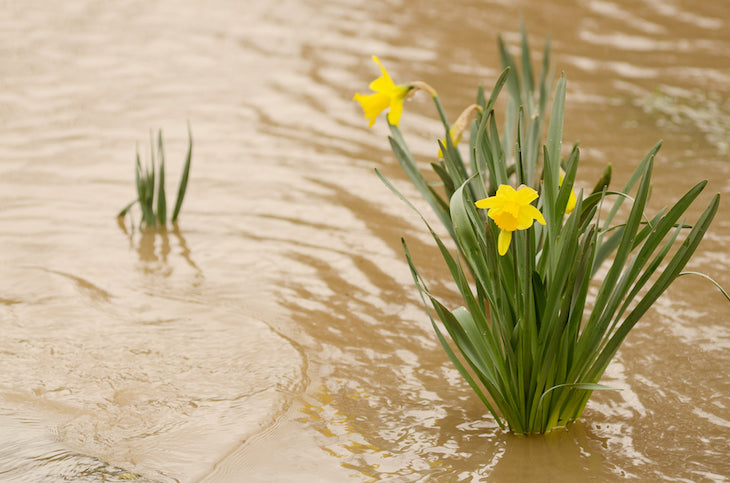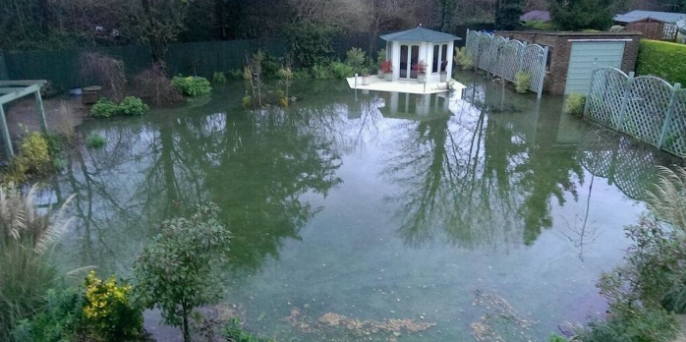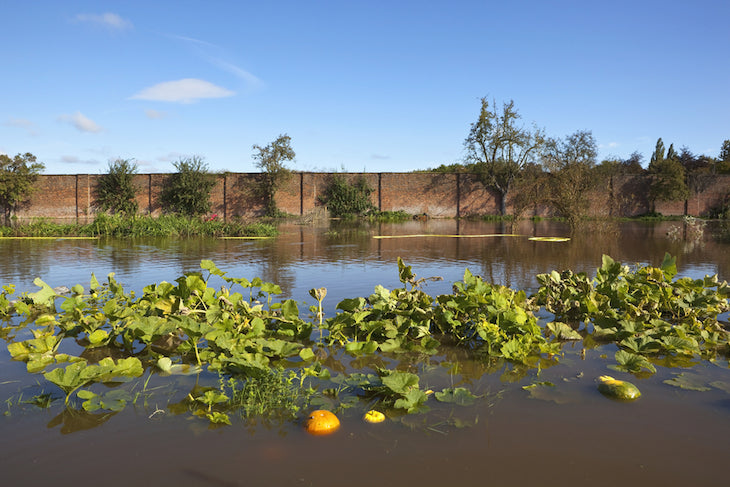Erratic weather in recent years has made flooding a common issue. Gardeners professional and private have seen their pride and joy destroyed by heavy rain and the resulting standing water.
Plants that are left in saturated soil for any length of time will drown as the water fills air pockets normally present in the soil. This starves roots of oxygen and causes yellow leaves, root rot and death.
So how can you help your garden to cope with the floods and save your plants from a watery grave?
Prepare and prevent

Image: samritphoto/Shutterstock
Prevention is key. And if your garden is prone to flooding, the best investment you can make is in your soil.
Gardening expert, Josh Ellison, writing at Floral & Hardy, recommends digging in plenty of garden compost or well-rotted manure as it’s:
“…excellent for absorbing water and also allowing it to drain once the soil or manure itself has become flooded.”
If your garden floods regularly, consider adding raised beds. These lift and protect plants above the level of flood water and can be built using paving slabs, timber or railway sleepers or purchased ready-made from garden centres.
Drainage

Image: Thanate Rooprasert/Shutterstock
Look at your garden and how it will drain. Even adding a slight slope to patio areas will help water flow away from your home. Digging trenches or adding piping for irrigation can also help drain lawns and flower beds. A bog garden or seasonal pond at the point where water collects are creative yet practical ways to catch surplus water.
Limiting paved and concrete areas which won’t let water soak into the ground, and creating beds and borders close to the house will also help with drainage.
Plant well

Image: TFoxFoto/Shutterstock
Roots break up soil, improving its structure and making it drain faster. Tree roots are particularly effective, and for this reason planting trees is a method used by farmers and the Environment Agency to help prevent flooding. Try it in your garden by planting trees and shrubs on raised areas and adding an additional mound around their base.
If a particular part of your garden is more prone to flooding, choose plants that can withstand some waterlogging. Willows, flag irises and violets are good plants to begin with.
Act on Weather Warnings

Image: sirtravelalot/Shutterstock
When weather warnings are issued don’t sit back - take action!
Pack your most precious plants into a solid structure or high up in your garden shed and cover any that can’t be moved with fleece or cloches. Dig ditches round larger trees and plants to keep the water at bay.
Make sure your electrical items are unplugged and safely stored on a higher shelf in your shed. The same goes for paint tins, oil cans — anything that might leak and contaminate the water.
Floodwater can contain contaminants, so pick your veg and raise any bags of compost out of harm’s way. Board up any buildings and garden sheds, especially fragile greenhouses and remove things anything that could float and cause damage like garden furniture and ornaments.
Weigh down manhole covers, and put netting over your pond so your plants and fish don’t float away.
After the flood
Once the rain stops, it’s tempting to take immediate action to save your garden. But wait a while to avoid causing further damage.
Keep off the Grass (and soil)

Image: www.yorkshiregardendesigner.co.uk
Wait until your garden has dried out. Walking on your wet garden will just make things worse – it breaks up the structure of the soil. So stick to the paths, or if you really need to access use a board or create temporary stepping-stones.
If your garden is waterlogged for a long time, Sally Tierney of the Yorkshire Garden Designer has this advice on rescuing your favourite plants:
“Although it is not a good idea to do any digging in waterlogged soil, if you have a particularly favourite plant… dig a trench round its roots to help speed up drainage. This should only be used for plants it would be very difficult or impossible to replace because you will compact a lot of other soil in doing this.”
Tread very carefully until the water has subsided.
Time to tidy

Image: EMJAY SMITH/Shutterstock
Once the water has cleared get out and start tidying. Make sure you wear boots, disposable gloves and overalls as the water may contain all sorts of nasties.
The first job is to gather up and discard debris and wash down hard surfaces to clear contaminants and wash leftovers from plant leaves.
Next aerate your lawn using a fork to encourage drainage. Spike the fork in at regular intervals leaving deep, visible holes. Add horticultural sand or grit to the holes to further improve drainage.
If the water has left a layer of effluent on the soil in your beds, just use your fork to clear it. Then add a surface mulch of well-rotted organic matter to help the ground recover, particularly if the water has been standing for any length of time.
You’ll need to throw away unharvested fruit and vegetable crops, as they may be contaminated. It’s prudent to avoid your herb garden for a year after flooding and then make sure you use them only in cooking, too.
Saving your garden from the storms is both a long term and short term project. Think about it when you’re planning and planting to help harden up your garden to cope with excess rainwater. And if the worst happens, draft in some helpers, clear up carefully, and replant when the skies clear.
Have you been affected by garden floods? Let us know how you coped on our Facebook page.




